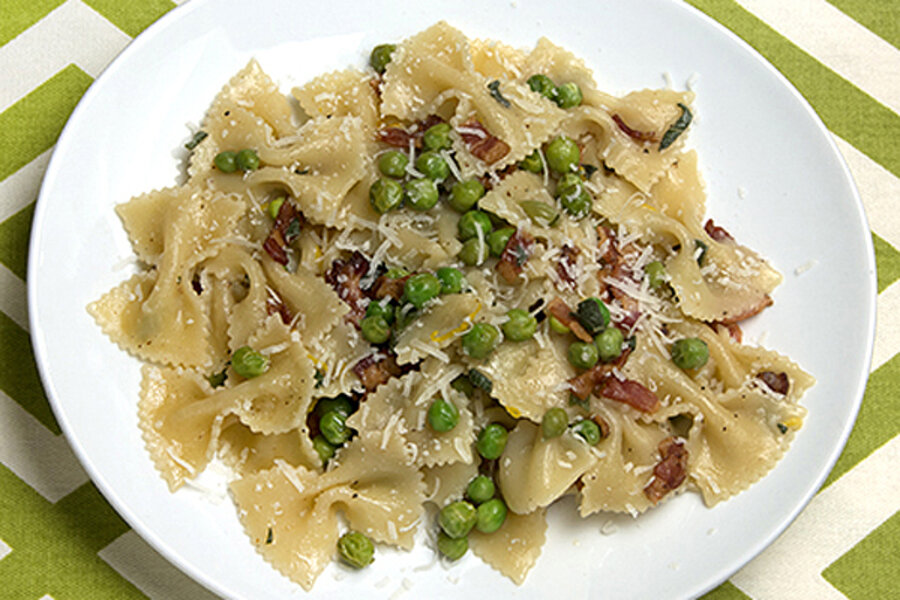Butterflies and a taste of spring: Farfalle with peas, bacon, and sage butter
Loading...
Circumstances converge, synapses fire. And sometimes, recipes happen. Recently, we were at the International Home + Housewares Show here in Chicago. We try to go every year, looking for new kitchen tools and trends.
There are always big, exciting discoveries and great conversations at the show. But there are also little asides, quiet incidental moments that we almost miss. One happened at Eataly’s booth. The giant purveyor of all things food and Italian opened a Chicago outpost this winter, as Marion reported here. At their Housewares Show booth, they were showcasing some of their wares and brewing up cups of amazing espresso. As Marion chatted with the barista, I picked up a recipe card. It was for squash-filled ravioli in a sage butter sauce. I ignored the ravioli and stowed the simple sauce (sage leaves browned in butter and mixed with reserved pasta water) away in my head for a future pasta dish idea.
Next came the lovely gift of Meyer lemons from Christina over at A Thinking Stomach, followed closely by mentions of the first peas of spring in various food magazines. A recipe started coming together. I added bacon and threw in some Parmesan to take this from interesting side dish to satisfying main course.
This being spring (although last night’s snow insists otherwise), I chose farfalle for my pasta. Here in the United States, we often mistakenly call it bow-tie pasta. Farfalle is actually Italian for butterflies, a much more poetic name, I think. Certainly more springlike.
I used a Meyer lemon because I had them on hand – and because they are delicious – but a regular lemon will do just fine here. And I used frozen peas because the fresh haven’t shown up yet, at least in my neighborhood. If you can get fresh peas in the shell, they will be wonderful and worth the effort of shelling them. If not, frozen peas are still beautifully green and taste like the promise of spring. As does the sage. I wondered if two tablespoons would be enough to even notice. Its presence flavored every bite, reminding me why sage is part of our tiny garden every year.
Farfalle with peas, bacon, and sage Butter
Serves 2
8 ounces uncooked farfalle (or other short pasta – see Kitchen Notes)
1 tablespoon olive oil
4 strips bacon, sliced crosswise into 1/4-inch matchsticks
Salt
2 tablespoons butter
2 tablespoons chopped fresh sage
1 cup peas, thawed if frozen (see Kitchen Notes)
1 cup pasta cooking water
Freshly ground black pepper
Zest of 1 lemon
2 tablespoons fresh lemon juice
1/2 cup freshly grated Parmesan cheese, plus extra
1. Start a large pot of water to cook the pasta. While water is coming to a boil, heat oil in a large sauté pan over medium flame and cook bacon until crisp, stirring occasionally. Drain bacon on a paper towel-lined plate. Drain fat from pan and wipe with paper towel, but do not wash.
2. When water comes to a boil, salt generously and cook pasta one minute less than package instructions call for. Two minutes before pasta is done, melt butter in sauté pan over medium flame and add sage, peas, bacon, and 1 cup of the pasta water. Drain pasta and add to pasta to pan, season generously with black pepper and stir to combine. Cook for 2 to 3 minutes, stirring occasionally. Stir in lemon zest, lemon juice and 1/2 cup Parmesan. Taste and adjust seasonings. Divide between two shallow pasta bowls and top with additional grated Parmesan. Serve.
Kitchen Notes
Go for the butterflies. Yes, you can use other short pastas. Shells will nicely capture peas and bits of bacon. But fanciful farfalle look so fun and springlike on the plate. And in this case, their almost meaty chewiness adds substance to the dish.
How many fresh peas? A generous pound of peas in their pods will yield about one cup of peas. Buy more. Eat the extras raw, straight from the pods. Trust me on this.






